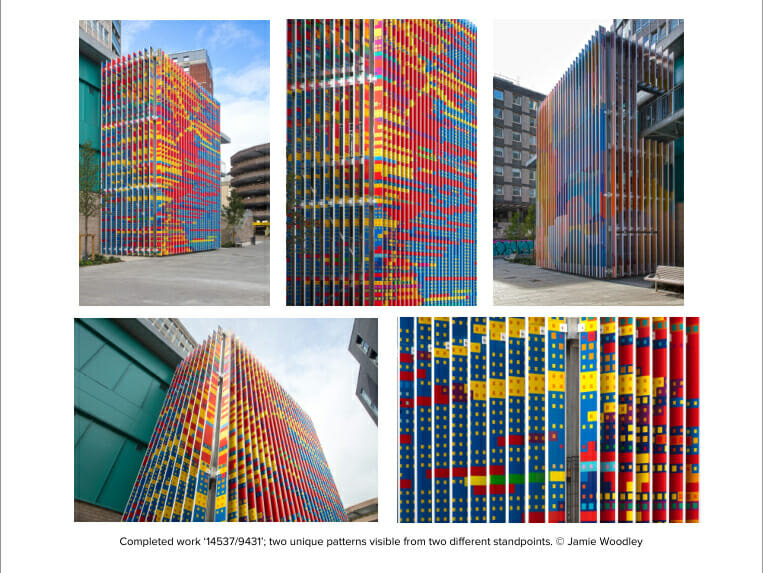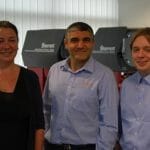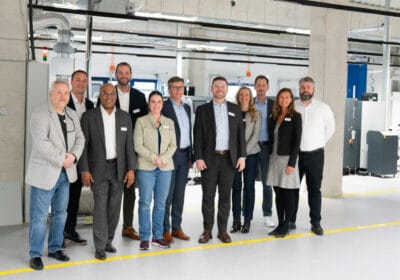A new public art installation in a pedestrian walkway, New Bridewell, in the centre of Bristol, has been completed. Produced by Ginkgo Projects and funded by developers Watkin Jones, the piece, ‘14537/9431’, forms the public art strategy of the New Bridewell student housing development. The work consists of two brightly coloured patterns cover one large façade, their visibility and arrangement shifting as they are walked past. The angle of the images means each is only fully visible from opposite sides of the walkway, forcing a viewpoint that is temporarily achieved. ‘14537/9431’ is a public artwork by artist Lilah Fowler that asks us to consider how we perceive our surroundings, but also explores how our landscape is intertwined with technology.
The two patterns displayed are derived from a custom-built computer programme, using changing, arbitrary data points to generate unlimited unique patterns; two of these computer-generated patterns have been applied onto the fins that line the building’s façade. Fowler worked with a programmer to develop the software in response to several aspects of Bristol’s industrial and intellectual history.
Paul Dirac (1902-1984) was a theoretical physicist who was born, raised and educated at the University of Bristol, and who went on to win a Nobel Prize (shared with, and somewhat overshadowed by, Erwin Schrödinger). Dirac established a general theory of quantum mechanics and is considered the founder of the field of quantum electrodynamics; a field that later resulted in the development of almost every form of our current electronic devices. Bristol, much later in the 1980s, became host to technology companies such as IBM, Toshiba and HP, as part of the so-called ‘Silicon Gorge’.
Fowler’s pattern-generating software reflects the early stages of data modeling where necessary, but random, parameters are set in order to enable the comprehension and visualisation of data. The results are intricate, unpredictable images that are also mirrors of our time. ‘14537/9431’ forms part of a body of Fowler’s work that reflects on technology and the contemporary landscape as having become inherently combined. It refers to the changing terms of our sense of space created by digital culture, where landscape is embedded with, and shaped by, technology, and virtual tools create a parallel mental and physical interpretation of our world.
Tom Littlewood, Director at Ginkgo Projects, said: ‘We have been delighted to work with Lilah Fowler to create ‘14537/9431’ as an integral dynamic focal point for new square for Bristol on Nelson Street. The work activates the space and plays its role as part of a new revitalised living environment for students within Bristol’.
Ginkgo Projects is an independent public art and cultural producer. Our philosophy is driven by a desire to create vision and experience led opportunities for artists and creative practitioners to work closely with clients, design teams and communities to build and reveal an authentic sense of narrative, place and distinctiveness within both urban and rural environments. We combine elements of research, strategy development, partnership building, art curation and landscape design to create authentic and innovative projects. Our clients come from both the commercial and public sectors and we welcome opportunities to develop partnerships and fresh approaches to creating new work.







